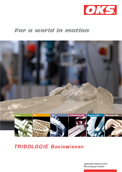Standards:
|
Standard/ |
Title |
Keyword/ |
Conditions |
Description |
|---|---|---|---|---|
|
DIN 267-27 Screw pastes |
Break away torque |
x Tightening torque |
M 10 A2/40 Nm/400 °C/100 h |
Ratio of break away torque required to release a screw connection compared to starting torque. Often following high temperature loading. |
|
DIN 51 350 Oils, greases, pastes |
Testing of lubricants; testing in the Shell-four-ball tester |
VKA test/ |
Welding Load: 1420 rpm |
Determination of characteristic values for lubricants that are suitable for use where high surface pressures occur in the mixed-friction zone between surfaces that move relatively to each other. The test makes use of a rotating ball, pressed against three identical, stationary balls. Measurements can be made of the force required to produce welding between the balls (welding load) or of the amount of wear on the balls after application of a defined force over a defined time. |
|
DIN 51 354-2 Oils, fluid greases |
FZG damage loading step |
Load stage |
A, 8,3/90 |
Testing of the load capacity of gear lubricants. |
|
DIN 51 354-2 Oils, fluid greases |
FZG wear |
mg/kWh |
A, 8,3/90 |
Testing of the load capacity of gear lubricants. |
|
DIN 51 806 Roller bearing greases |
SKF R2F Operting Test A |
none |
2500 rpm, 20 d |
Determination of lubricating properties of rolling bearing greases at room temperature (Operating Test A) and at a defined temperature (Operating Test B). |
|
DIN 51 807-1 Greases (pastes) |
Testing of lubricating greases in the presence of water, static test |
Water resistance/ |
Specified temperature (usually 90 °C), distilled water, 3 h test duration |
A 1 mm thick layer of lubricating grease is applied to a glass plate and is subjected to the effect of still water for 3 hours at a specified temperature. Afterwards, any changes will be evaluated. |
|
DIN 51 807-2 Greases (pastes) |
Testing of lubricating greases in the presence of water, dynamic test |
Water resistance/ |
1 h, 40 °C or 80 °C water temperature, 600 rpm |
Water is sprayed on a grooved ball bearing that is filled with lubricating grease. The change in the mass of the grease in the bearing is measured. |
|
DIN 51 810-1 Rolling bearing greases |
Determination of shear viscosity of lubricating greases using a rotation viscosimeter |
Apparent dynamic viscosity/ |
For lubricating greases in NLGI classes 000 to 2 at constant shear rate. Test run at stipulated speeds and times. |
The shear viscosity of lubricating grease is determined by measuring the torque at a constant temperature and speed. The initial and final viscosity are measured. The shear viscosity indicates the stability of a grease. |
|
DIN 51 818 Greases |
Lubricants; consistency classification of lubricating greases; NLGI grades |
NLGI grades/ |
Measurement of the worked penetration after 60 double cycles at 25 °C as defined in DIN ISO 2137 |
Classification of lubricating greases by level of worked penetration for simple marking of products to indicate consistency. |
|
DIN 51 821 Roller bearing greases |
Testing of lubricants using the FAG FE9 rolling bearing test device |
FE 9 |
Lubrication greases NLGI 1 to 4, between 120 °C an 200 °C |
Mechanical dynamic testing of lubricants to determine the lifespan under realistic conditions. Several bearings are filled with grease and tested until they fail. The test method described in part 2 is used to determine the upper operating temperature for rolling bearing greases. Under these test conditions: installation type A, axial load 1500 N and speed 6000 rpm, the grease achieved 100 hours at the to-be-stated temperature. The probability of bearing failure is 50 % (F50). |
|
DIN 51 834-2 Oils |
Testing of lubricants; Tribological test in the translatory oscillation apparatus (SRV). Determination of measured quantities for friction and wear for lubricating oils |
SRV test/ |
Cylinder/disc, 450 N, 1000 µm, 50 Hz, 2h (OKS standard) |
The test establishes the friction coefficient between the specimens and the wear on the specimens after a specified test duration. |
|
DIN EN ISO 16047 Screw pastes |
Thread friction coefficient |
µ |
Screws: ISO 4017 M10x55-8.8 vgs |
Determination of friction coefficient by tightening of threaded fasteners. |
|
DIN ISO 2137 Greases, pastes |
Penetration |
|
|
Determination of the consistency of a lubricant with and without application of shear stress. |
|
E DIN 51 833 Assembly pastes |
Press-fit-test |
µ, N |
Testing of the lubricating effect of pastes under very high pressures at low speeds. |
|
|
SEB 181 302 Roller bearing greases |
Timken |
mg |
43 lbs |
Determination of the wear protection properties of a rolling bearing grease for a defined load |
|
Standard/ |
Title |
Keyword/ |
Conditions |
Descriptions |
|---|---|---|---|---|
|
DIN 50 017 |
Condensation water test |
Degree of corrosion |
µm, h |
Testing of corrosion protection properties in humid atmospheres for a defined coating thickness (µm) until the first traces of rust appear (h). |
|
DIN 50 021 |
Spray tests with different sodium chloride solutions |
Degree of corrosion h |
DIN 53 210 |
Testing of corrosion protection properties in a salty atmosphere |
|
DIN 51 802 Roller bearing greases |
Testing lubricating greases for their corrosion inhibiting properties |
SKF EMCOR/ |
Three times 8 hours of operation each interrupted by 16 hour breaks at room temperature using distilled water. |
Testing of corrosion protection of greases when used in rolling and friction bearings. The grease is tested by adding distilled water to ball joint bearings. Then the tracks of the outer rings are checked for corrosion. |
|
DIN 51 808 Greases |
Determination of oxidation stability of lubrication greases, oxygen method. |
Oxidation stability/ |
100 h or 400 h, 99 °C, initial pressure 7.0 bar |
Oxidation stability provides information about the behaviour of thin layers of lubrication grease, such as in rolling bearings that are subjected to atmospheric effects under static conditions over a long period of time. The test is carried out at a specified pressure for 100 for 400 hours at 99 °C. Afterwards, the drop in pressure is measured. This doesn't say anything about the shelf life of packaged grease substances. |
|
DIN 51 811 Rolling bearing greases |
Testing of the corrosive effect of lubrication greases on copper, copper strip test method |
Copper corrosion/ |
24 h/100 °C (OKS Standard) |
This test is used to determine how corrosive lubricating grease is to copper. A smoothed copper strip is immersed in the lubricating grease for 24 h at a constant temperature, usually 50 °C or 100 °C. Afterwards, the corrosion grade is determined based on the discolouration. |
|
Aqueous substances |
pH value |
|
Standard/ |
Title |
Keyword/ |
Conditions |
Description |
|---|---|---|---|---|
|
DIN 50 981 |
Layer thickness |
µm |
DIN 50 982-2 |
Determination of layer thickness. |
|
DIN 51 412-1 Oils |
Testing of petroleum products; Determination of the electrical conductivity |
Electrical conductivity/ |
at 23 °C |
Procedure for measurement of the electrical conductivity of liquids. Cannot be used with insulating oils. The test makes use of a conductive receptacle containing approx. 100 ml of the liquid under test, to which a direct current voltage of 100 V is applied. The electrical conductivity can be calculated from the measured voltage drop. |
|
DIN 51 562-1 Oils |
Viscosimetry; Measurement of kinematic viscosity using the Ubbelohde viscometer; Part 1: Geometrical design and performance of measurements |
Viscosity/ |
at 40 °C, at 100 °C |
Method for the determination of the kinematic viscosity of transparent, Newtonian liquids in the range 0.35 mm²/s to 100,000 mm²/s at temperatures between 10 °C and 100 °C. The test measures the time taken for a certain volume (measured by two ring marks) of the liquid under test to flow through a capillary tube under the influence of gravity. |
|
DIN 51 581 Oils |
Determination of evaporation loss |
Evaporation loss/ |
T = 250 °C, 60 min |
Determination of evaporation loss of an oil over a specified time period t at a specific temperature T. |
|
DIN 51 755 Oils, solvents |
Determination of flash point using the Abel-Pensky closed cup method |
Flash point/ |
Temperature range from 5 °C to 65 °C |
Determination of flash point of mineral oils and other combustible liquids. Other tests are used for higher flash points. |
|
DIN 51 757 Oils |
Determination of density of mineral oils and related substances |
Density/ |
at 15 °C |
To convert mass to and from volume. |
|
DIN 51 805 |
Determination of flow pressure of lubricating greases, Kesternich method |
Flow pressure/ |
Lower operating temperature for lubricating greases according to DIN: flow pressure < 1.400 mbar |
A test nozzle filled with lubricating grease is connected to a pressurized gas source and a pressure gauge. At a specific, constant temperature, the pressure is continually increased until the lubricating grease rope snaps and the pressurized gas escapes through the nozzle. The lower operating temperature for lubricating greases according to DIN 51 825 is defined by the flow pressure as maximally 1400 mbar. |
|
DIN 51 813 Greases |
Determination of the amount of solid substances in lubrication greases, particle sizes > 25 µm |
Solids content/ |
Only for soap-based lubrication greases without added solid lubricants |
Determination of the amount of solids, impurities in lubricant greases that can cause lubrication problems, noise and wear. 500 g of the grease is pressed through a sieve. Then, the residue in the sieve is mixed with a solvent and impurities are washed out. |
|
DIN 51 817 Greases (Pastes) |
Determination of oil separation from lubricating grease under static conditions |
Oil separation/ |
t/T |
Determination of the bleed properties over a specified time period t and temperature T |
|
DIN 51 832 Powder |
Particle size |
µm |
d 50, d 99, max. |
Determination of average (d50) and maximum (d99) particle size. |
|
DIN 52 612 Thermally conductive pastes |
Thermal conductivity |
W/mK |
Testing of thermal conductivity of a substance. |
|
|
DIN 53 481 Insulating pastes, Thermally conductive pastes |
Dielectric strength |
kV/mm |
at 20 °C, 0,05 inch separation |
Electrical testing. |
|
DIN 53 482 Insulating pastes, Thermally conductive pastes Electrical greases |
Specific resistance |
Ohm x cm |
at 25 °C, |
Testing of electrical resistance of a substance. |
|
DIN 58 397-1 Oils |
Evaporation loss |
Weight percent |
t/T |
Determination of the evaporation loss of a lubricant over a defined period of time, t, at a defined temperature, T. |
|
DIN EN 22719 Liquids |
°C |
> 79 °C |
Lowest temperature at which the evaporating oil can be ignited by an external ignition source. |
|
|
DIN EN ISO 3838 All substances |
Density |
g/ml |
at 20 °C |
|
|
DIN ISO 2176 Greases, pastes |
Drop point |
°C |
Temperature at which the structure of the grease breaks down. |
|
|
DIN ISO 3016 Liquids |
Pourpoint |
°C |
3 °C steps |
Temperature at which the oil first becomes capable of flow. |
|
Insulating pastes |
Dielectric constants |
1 kHz - 10 MHz |
Electrical testing. |
|
|
Insulating pastes |
Arc stability |
s |
Electrical testing. |
|
|
Insulating pastes |
Dielectric loss factor |
tan |
1 kHz - 10 MHz |
Measurement of dielectric loss factor. |


